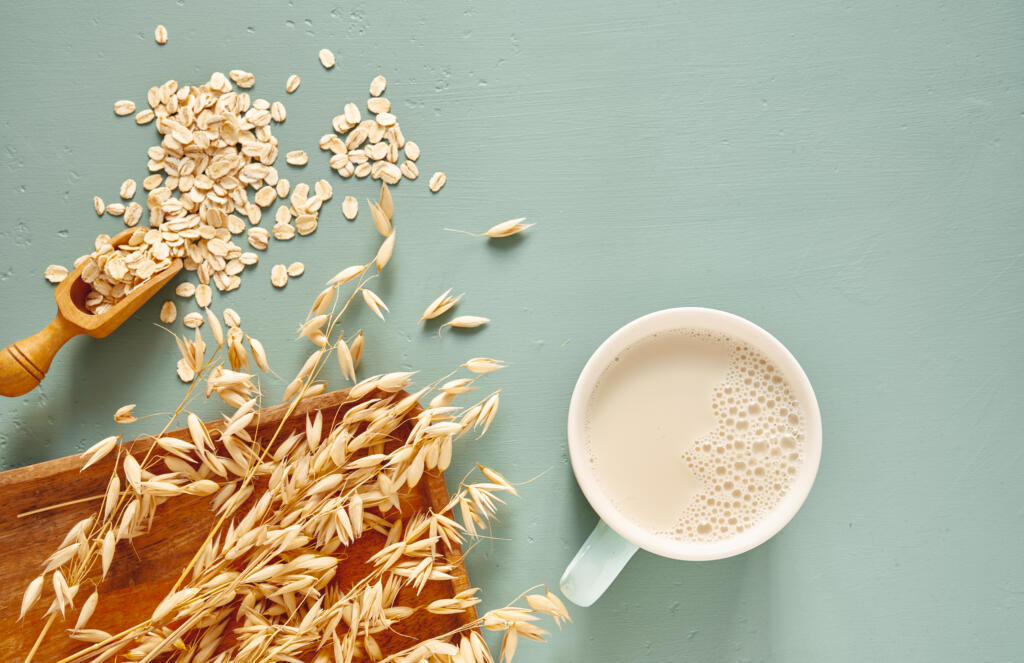Ever wondered why oat milk separates when added to coffee? You’re not alone! Many people have noticed that adding oat milk to their morning cup of joe results in an unappetizing, lumpy mess. In this post, we’ll explore the science behind this phenomenon and provide tips for avoiding it.
What is the curdling problem?
The curdling problem is common in coffee and tea when using oat milk. It occurs when the non-dairy milk is affected by the heat and acidity of the beverage, resulting in a reaction. As a result, the oat milk separates from the liquid, leaving a lumpy or curdled texture. This issue can be caused by various factors, which are explained below.

The science behind why oat milk separates in coffee
The science behind why oat milk separates in coffee is quite simple. Oat milk, unlike dairy-based milk, is not homogenized to hold the fat and water molecules together. This lack of homogenization means that when the oat milk is subjected to a certain level of acidic environments, such as that found in hot coffee, it will naturally separate due to acetic acid.
The fat in the oat milk also contributes to this separation. High heat or long storage periods can further cause the oat milk to curdle. Knowing this scientific explanation can help inform you how to prevent oat milk from separating when making coffee.
Reasons why oat milk separates in coffee
There are several reasons why oat milk might separate from coffee, such as:
Types of oat milk
Several types of oat milk are available on the market, from fortified to unflavored and everything in between.
Unfortified oat milk is made from oats, water, and a small amount of oil. Fortified oat milk contains vitamins and minerals, such as calcium and vitamin D, which make it a healthier choice for those looking for a dairy-free milk alternative.
Oat milk can also be found in flavored varieties such as vanilla or chocolate, which can make a great addition to coffee or tea. For those looking for an even creamier option, there is also homogenized oat milk, which has been processed so that the proteins are suspended throughout the milk rather than settling on the surface.
The acidic reaction
The acidic reaction of oat milk in coffee is a common issue that many people experience. The acidity in the coffee reacts with the lactic acid in the oat milk, causing it to curdle. This reaction can be exacerbated when the coffee is too hot or when the oat milk is not properly emulsified.
Heat stability of oat milk
Another reason oat milk separates from coffee is its lack of heat stability. Oat-based synthetic milk substitute is a simpler mixture and mostly a suspension of fine solids with some oil added for texture, which is not as stable as other types of milk.
This means that when exposed to high temperatures, oat milk is likely to curdle and separate from coffee.
It’s important to reduce the temperature of your coffee before adding oat milk or other non-dairy milk substitutes to avoid this.
Storage temperature
Oat milk is more prone to curdling if stored at high temperatures. It is important to ensure that oat milk is stored in a cool and dry place, away from direct sunlight or high temperatures. It is also best to use refrigerated oat milk, as this will help it to remain fresh and prevent it from separating in coffee.
The thickness
The thickness of the oat milk can also be a factor when it comes to oat milk curdling in coffee. If the oat milk is too thick, it will not mix properly with the coffee and can lead to separation.
Oats can be soaked in water before blending to make them thicker, but this can sometimes result in food that has more moisture than a recipe anticipates. This process can cause the oat milk to curdle when exposed to certain acidic environments.
The moisture content of the food
The moisture content of the food is often overlooked as a potential cause of curdling. Oat milk is a very absorbent food, meaning it can draw in more moisture from its environment than other dairy-free milk. When this happens, the oat milk can become too thick for coffee and start to separate.
Sugar content
If the oat milk contains too much sugar, it can cause the proteins to coagulate and separate. High sugar levels can increase the beverage’s acidity, leading to curdling.
Therefore, choosing oat milk with a low or moderate sugar content is important if you wish to avoid separation in coffee or tea. Additionally, reducing the amount of sweetener added to your beverage can help prevent the proteins in oat milk from coagulating and separating.
Using a grinder with oat milk
Using a grinder with oat milk can also contribute to curdling. The grinder’s blades can shred the oat milk particles into too small pieces, creating a paste-like texture that is more prone to curdling when exposed to heat or acidity.
If you are grinding oat milk for use in coffee, it is best to use the finest setting on your grinder and not grind the oat milk too fine. This process will help prevent the oat milk from curdling in the coffee.
Brewing temperature
Brewing temperature is another factor that can cause oat milk to separate in coffee. If the temperature is too high, it can cause the oat milk to curdle. Ensure your coffee’s temperature is not over 200 degrees Fahrenheit to avoid this.
Low-temperature brewing is ideal as it will help keep your oat milk from separating. Brewing at a lower temperature also helps preserve your coffee’s flavor.
How to Avoid Oat Milk Separating in Coffee

Know the properties of oat milk
Oat milk has a lower fat content than other non-dairy milk, making it more likely to separate when exposed to the acidity and heat of the coffee.
Additionally, oat milk is not as heat-stable as other types of milk, meaning that it is more likely to curdle if added directly to hot beverages. To prevent separation, one should know how the different types of oat milk vary in fat content, heat stability, and sugar content.
Use unsweetened oat milk
Using unsweetened oat milk is one of the best ways to avoid curdling in coffee. Oat milk contains natural sugars, which are more likely to cause the milk to separate and curdle when heated. An unsweetened version can reduce the risk of the milk separating and curdling in your coffee.
Additionally, unsweetened oat milk is lower in calories and fat, making it a healthier option for your coffee. It’s also important to remember that other foods, such as citrus fruits and acidic sauces, may also cause the milk to separate, so be sure to avoid adding any of these items to your coffee.
Reduce the temperature of your coffee
Reducing your coffee’s temperature can help prevent the curdling of oat milk. Oat milk is a great dairy-free alternative to traditional cow’s milk, but it can separate when added to hot coffee. If you’re looking for a creamy and smooth cup of coffee, it’s important to take steps to maintain the temperature of your drink.
Lowering the heat can help keep your oat milk and coffee from separating. While oat milk may still separate at lower temperatures, it’s less likely than if you pour in boiling liquid. This simple step can go a long way in preserving the taste and texture of your beverage.
Heat the oat milk before adding it to coffee
One way to avoid oat milk separating in coffee is to heat it before adding it. This helps reduce the fat content and makes the oat milk more soluble in hot water. To do this, transfer the oat mixture to a blender and pulse it a few times before blending on medium-high speed for about one minute.
Alternatively, drain off the original liquid and heat it on the stove or in the microwave. Once heated, add the oat milk to your coffee or tea and stir thoroughly.
Stir the oat milk and coffee together
Stirring the oat milk and coffee together is a simple yet effective way to prevent oat milk from separating. This is because stirring helps to evenly distribute the temperature of both ingredients and ensures that the oat milk does not become too hot or too cold.
Additionally, stirring helps to break up any clumps of oats that may have formed during preparation, ensuring a smooth and creamy cup of coffee. For best results, stirring the oat milk and coffee for at least 30 seconds is important to ensure a homogenous mixture.
Add a stabilizer
Adding a stabilizer like cornstarch, arrowroot powder, or xanthan gum can help keep the fats and proteins in the oat milk from separating when added to hot liquids. These stabilizers are easy to find in most grocery stores and can be added to the oat milk before adding it to coffee.
Depending on the type of oat milk you use, you may need to adjust the ratio of stabilizer added to the oat milk. Adding too much can cause the oat milk to become overly thick and creamy, while too little will not provide adequate protection against curdling. Experimenting with these additives can help you find the right balance for your specific needs.
What are the alternatives to oat milk in coffee?
For those looking for an alternative to oat milk in their coffee, a variety of other plant-based milk can be used.
Soy milk is one of the most popular and widely available plant-based milk, and it can be used as a direct substitute for oat milk.
Almond milk, coconut milk, and even hemp milk are all great alternatives to oat milk that will not separate in coffee. These milk all vary in flavor, so it may take trial and error before finding the right one for your needs.
Remember that this milk may not always foam the same way as oat milk does when steamed or frothed.
Conclusion
Understanding why oat milk can separate when added to coffee is important. The most common causes of this problem are the acidity of the coffee, the heat stability of oat milk, the thickness of the food, and the moisture content.
It is recommended to use unsweetened oat milk, reduce the temperature of your coffee and stir the oat milk and coffee together to avoid oat milk separating in the coffee. Following these tips, you can enjoy delicious drinks without worrying about curdling.
Disclaimer: This post contains affiliate links, which means I may receive a small commission, at no extra cost to you, if you make a purchase using these links. Remember to support us by purchasing through the Amazon/Walmart/Impact Radius links provided. Last update on 2024-04-19 / Affiliate links / Images from Amazon Product Advertising API
Disclosure: No compensation or free products were received in exchange for writing this review.

Editorial Staff
The editorial staff at Crazy Coffee Crave is a team of coffee enthusiasts & Baristas who enjoy the one thing we all think about as soon as we get up in the morning. Trusted by thousands of readers worldwide.





